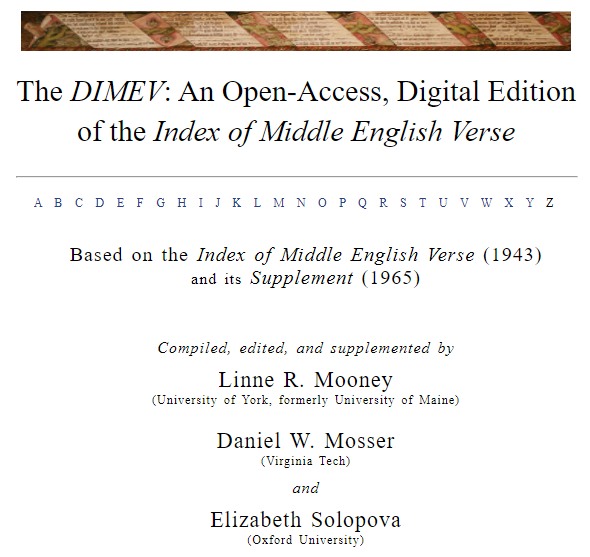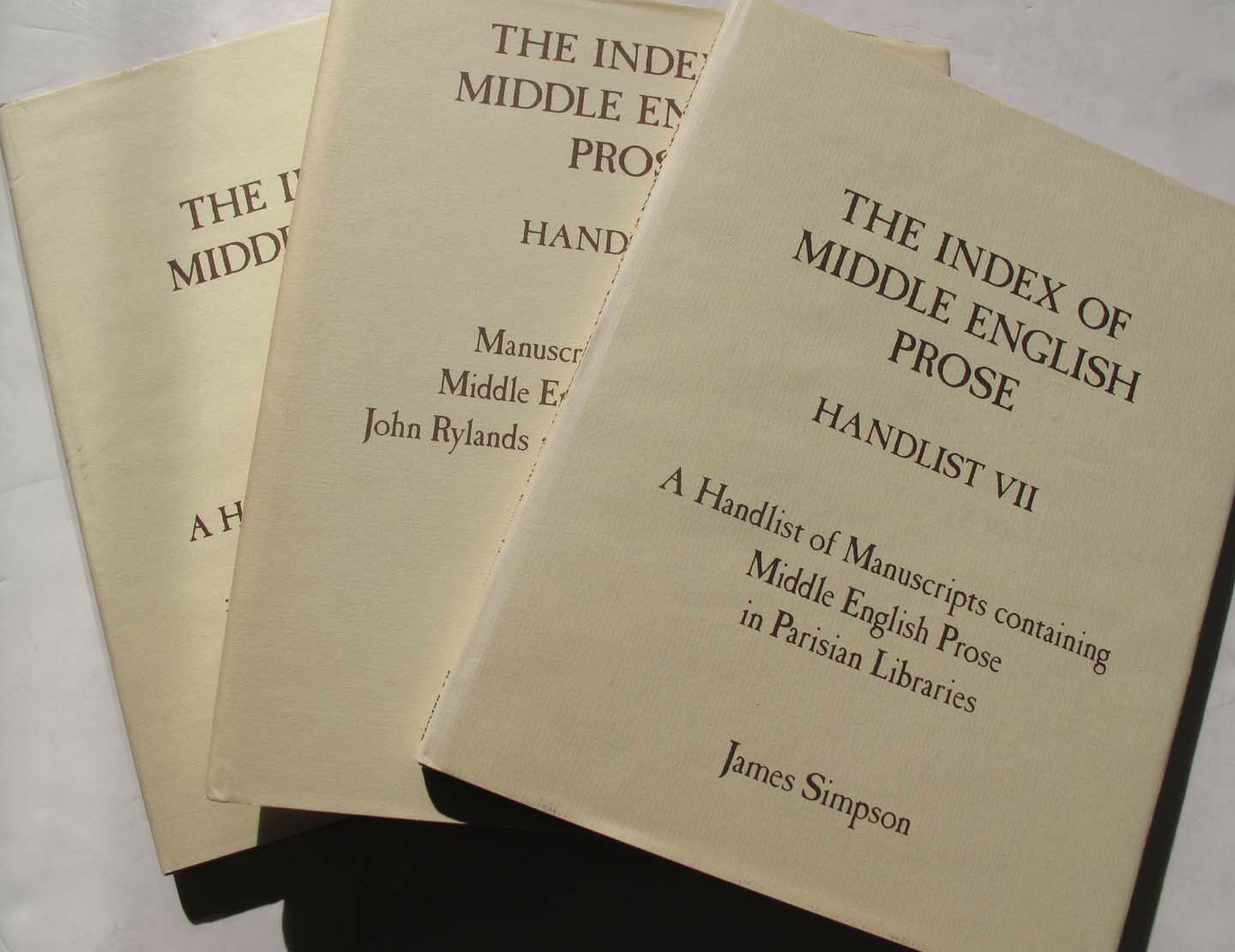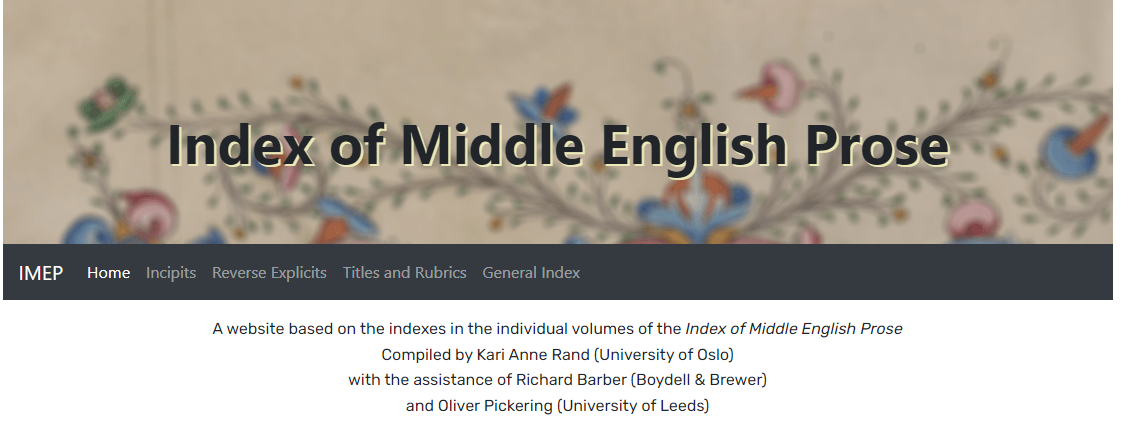The starting point for both is similar enough. Both aim to map comprehensively everything that is out there, with one focusing on works written in poetic metre, the other without.
The Index of Middle English Prose seeks to identify all surviving copies of texts written in English and in prose between 1200 and 1500. Foundations for the project were laid more than 40 years ago in 1978 at a conference in Cambridge called Problems in Middle English Prose. The first three volumes were published in the early 80s. There are currently 23 published volumes, and the project is still going on with several more volumes in progress. The availability of a comprehensive index will be a major asset for scholarship, as it will give us a complete picture of everything that is out there. Otherwise there is a danger that too much scholarship will focus only on things that have been edited. As Jolliffe (1974: 12) remarked of religious prose: “[s]ometimes the reader is left with the impression that apart from these works, no Middle English religious writings existed”.
IMEP’s verse counterpart, the Index of Middle English Verse, was started several decades earlier. Planning for the IMEV began in the late 1930s. In the Introduction to the first volume of IMEV, its editors Carleton Brown and Rossell Hope Robbins describe, how “[o]n the last day of August, when the Editorial Committee met in New York, the Germans were marching into Poland” (Brown & Robbins 1943: v). The latest version of the IMEV, the Digital Index of Middle English Prose (DIMEV) was published in 2010 and continues to be added to.
Both these projects originate in the 20th century and the pre-digital era. Both have made a transition into digital form in the 21st century. There are, however, decisive differences between how the two series were planned and how they have developed.
IMEV was originally published as a single volume, which came out in 1943 and sought to cover all collections, listing the first lines of ME verse in alphabetical order. As it inevitably left some texts out, it was supplemented in later editions. The most recent version is the Digital Index of Middle Verse (DIMEV) That online source contains the material found in the print Index of Middle English Verse (1943) and in the Supplement to the Index of Middle English Verse (1965), as well as the large amount of verse that has subsequently come to light.

IMEP in contrast has proceeded collection by collection with the publication of handlists, which usually cover a single collection in a single repository (sometimes several repositories are covered by a single volume, such as volume 15 on Midland libraries; sometimes, with large libraries such as the British Library or the Bodleian, only one collection in the repository is covered). Each of these handlists functions as a descriptive catalogue to its volume and often makes a considerable contribution to scholarship. In fact, the word ‘index’ found in the title is something of a misnomer.

According to the OED, the word index in its modern, most commonly used sense, is ‘an alphabetical list, placed (usually) at the end of a book, of the names, subjects, etc. occurring in it, with an indication of the places in which they occur. One work may have several indexes, e.g. an index of names of persons and places, of subjects, of words, etc.’ The IMEP handlists are descriptive catalogues rather than indexes.
A further difference has to do with text numbering. The IMEV assigns a number to each work. The IMEP plans to do so, but only once the project is completed. The current handlists are seen as waypoints to a final synoptic tool that will combine them all into one unified future resource.
These differences in approach are reflected in naming practices. Unlike the DIMEV, which specifies it is digital, the online version of the IMEP is simply called the Index of Middle English Prose without ‘Digital’ in front of it. The reason is that the website is envisaged as the final synoptic tool, which brings all the volumes together. It is not a digital version of a printed reference work, but the reference work itself.

Yet another difference has to do with the treatment of spelling variation. Middle English is notoriously the period when English lacked a standard writing system, which led to a huge amount of variation in the written language. This variation can be difficult for a search tool. The IMEV deals with this problem by normalising the spellings of the items it records. The IMEP does not. In fact, the development of a tool that is able to handle spelling variation, using language modelling, is a major part of the current project and will be the subject of a later blog post.
References:
Brown, Carleton and Rossell Hope Robbins. 1943. The Index of Middle English Verse. New York: Columbia University Press.
Digital Index of Middle English Verse: Digital Index of Middle English Verse (dimev.net)
Index of Middle English Prose. IMEP - Index of Middle English Prose (cam.ac.uk)
Jolliffe, P. S. 1974. A Check-List of Middle English Prose Writings of Spiritual Guidance. Toronto: Pontifical Institute of Mediaeval Studies.
Pickering, Oliver S. “The Computerisation of the Index of Middle English Prose: The Way Forward?”, Leeds Studies in English, n.s. 27 (1996), 163-71. [hyperlink]
Rand, Kari Anne. 2014. “The Index of Middle English Prose: An Assessment after Twenty Volumes.” Studia Neophilologica 86: 134-143.
.jpg)